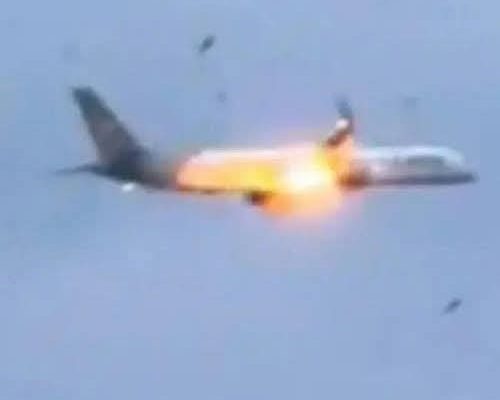A Tragic Aviation Disaster That Shook the World
Air travel has long been considered one of the safest and most reliable means of connecting people across continents. Every day, millions of passengers step onto planes with faith in the science, engineering, and professionalism that make modern aviation possible. Yet, despite these advancements, rare but devastating tragedies still occur—events that remind us of both the fragility of human life and the importance of continued vigilance in aviation safety.
Earlier today, the world witnessed one such heartbreaking moment. A large passenger aircraft, carrying more than 240 people, suffered a catastrophic incident that ended in disaster. What started as a routine journey transformed in an instant into one of the darkest days in recent aviation memory.
Possible Factors
-
Mechanical Failure
-
Aviation technology includes multiple redundant systems, but even advanced machinery is not immune to rare breakdowns. Engines, hydraulics, or critical flight control systems could potentially fail in catastrophic ways.
-
-
Weather Conditions
-
Sudden storms, turbulence, or atmospheric phenomena such as wind shear are known to place extraordinary stress on aircraft. Pilots are trained to navigate these challenges, but nature can be unpredictable.
-
-
Human Error
-
Despite rigorous pilot training and strict safety standards, human error remains a factor in some aviation accidents. Fatigue, communication breakdowns, or misinterpretation of data can contribute to tragedy.
-
-
Other Scenarios
-
Investigators also consider bird strikes, air traffic control errors, or external hazards. Every possibility must be reviewed systematically before any conclusions are drawn.
-
One aviation official emphasized the importance of patience: “It is too early to assign blame. Our mission is to gather evidence—black boxes, air traffic records, maintenance logs—and only then can we speak with certainty.”
Families and Human Loss
Statistics often dominate headlines, but behind each number is a human life—a son or daughter, a parent, a friend, a colleague. In waiting rooms across several countries, the true cost of this disaster was visible in the faces of grieving relatives.
One mother, clutching a stuffed toy belonging to her teenage daughter, said quietly: “She was so excited to travel. I told her to be safe. I never thought this would happen.”
Counselors and community leaders stood by to offer comfort, but no words could fully ease the anguish. The grief was made heavier by uncertainty, as many families waited hours before receiving official confirmation about their loved ones.
Global Response
The tragedy quickly transcended borders. Leaders from multiple nations expressed condolences, offering assistance to both rescue operations and the investigation. The International Civil Aviation Organization (ICAO) pledged to provide technical support and guidance, ensuring that lessons learned from this incident would strengthen global safety standards.
Social media erupted with messages of solidarity. Hashtags calling for prayers and support for the victims’ families trended worldwide. Candlelight vigils were organized within hours in cities across the globe, demonstrating how deeply interconnected the world has become.
A world leader captured the shared grief in a televised address: “This tragedy is not confined to one nation. It is a reminder that air travel connects us all—and when disaster strikes, the sorrow belongs to humanity itself.”
Aviation Safety and Lessons Learned
Aviation remains one of the safest forms of transportation, with accidents per flight decreasing significantly over the decades. The rarity of such disasters is precisely why they receive worldwide attention when they occur. Every investigation, painful as it is, becomes a vital step toward preventing future tragedies.
Aircraft are built with multiple backup systems: dual engines, layered hydraulic controls, and advanced computer monitoring. Pilots undergo years of training to handle emergencies. Air traffic controllers coordinate around the clock to keep the skies safe. Yet, the very nature of aviation means that when something does go wrong, the consequences are severe.
Experts stress that safety improves most through transparency. Sharing findings, enforcing new regulations, and applying lessons learned have historically made air travel safer for future generations.
Reflection and Healing
Beyond the technical questions lies a more human one: how do families, communities, and nations heal after such a sudden and overwhelming loss?
Faith leaders across traditions called for compassion and resilience. One widely shared reflection reminded people: “He who remembers the fragility of life learns to live with greater kindness.”
For those grieving, professional support from therapists and counselors can help manage the profound emotional impact. Communities often come together in solidarity, offering meals, shelter, and emotional comfort to affected families.
Looking Ahead
The coming days and weeks will bring more clarity. Passenger lists will be finalized, flight data recorders will be analyzed, and technical reports will slowly piece together the final moments of the aircraft. Families will continue to wait, supported by volunteers, officials, and strangers moved by empathy.
Even after the cause is known, grief will remain. Yet, each investigation not only seeks answers for those directly affected but also contributes to the broader mission of making the skies safer for all.
Conclusion: A Shared Human Story
More than 240 lives may have been lost in an instant, but their stories will continue to resonate. They were teachers, students, parents, newlyweds, travelers, and dreamers—each with a unique journey, each loved by someone waiting for their return.
This tragedy reminds us of the fragility of life and the need to treat one another with compassion. It urges the aviation industry to remain vigilant, continually striving for greater safety. And it calls on humanity to remember that in times of sorrow, borders dissolve, and we are united by shared grief and shared hope.
As investigators work and communities mourn, the world offers one collective prayer: that the departed may rest in peace, the grieving may find strength, and that from this darkness, lessons will emerge that help safeguard future generations.



